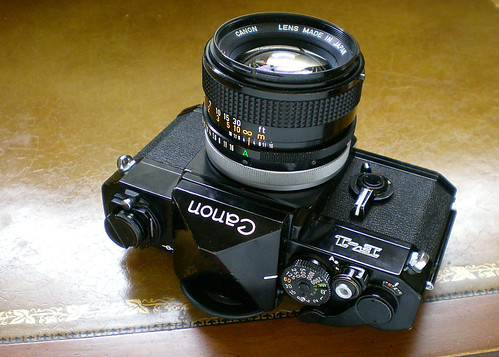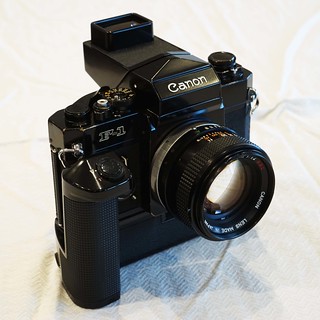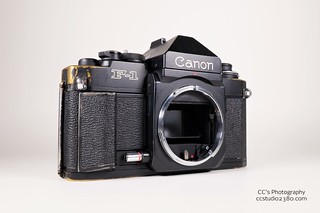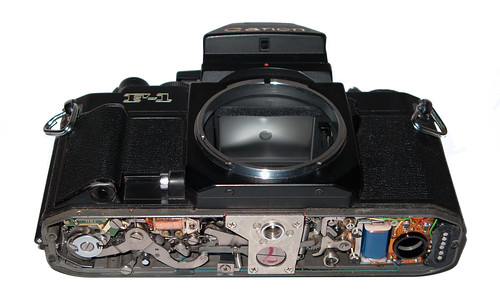Difference between revisions of "Canon F-1"
| Line 17: | Line 17: | ||
The '''[[Canon]] F-1''' is a [[35mm]] [[SLR]] camera introduced in the summer of 1970, together with the new [[Canon FD mount | Canon FD lens mount]]. It became generally available the following year. An FD lens fully communicates with the camera, and there is a capable range of lenses to choose from. They are backward compatible with the earlier Canon cameras. The FD lenses have an Automatic position on the aperture ring, at first identified by a green circle, later by a green A. This position is excluded if the lens is on a camera not supporting the automatic mode. The 1 to 1/2000 sec shutter has horizontally running metal foils curtains. | The '''[[Canon]] F-1''' is a [[35mm]] [[SLR]] camera introduced in the summer of 1970, together with the new [[Canon FD mount | Canon FD lens mount]]. It became generally available the following year. An FD lens fully communicates with the camera, and there is a capable range of lenses to choose from. They are backward compatible with the earlier Canon cameras. The FD lenses have an Automatic position on the aperture ring, at first identified by a green circle, later by a green A. This position is excluded if the lens is on a camera not supporting the automatic mode. The 1 to 1/2000 sec shutter has horizontally running metal foils curtains. | ||
| − | |||
| − | |||
| − | |||
| − | |||
| − | |||
| − | |||
| − | |||
| − | |||
The [[TTL|'''TTL metering''']] on the Canon F-1 is a remarkable feature. The [[Light meter|photocell]] is neither in the [[Pentaprism|finder prism]] nor behind the [[SLR]] mirror, but on the side of the focusing screen, which directs a fraction of the light to it. In this way the meter works independently of the attached finder, dramatically simplifying the viewfinders as well as the metering system in the camera. The beauty of it is the focusing screen with an embedded mirror. The exposure meter uses the 1.35 volt [[Mercury Cells|mercury battery]], which fortunately may be replaced, using an ordinary hearing aid battery that is so cheap that it doesn't matter how long they last. The finder prism is neatly slid on, and focusing screen is easily lifted out. | The [[TTL|'''TTL metering''']] on the Canon F-1 is a remarkable feature. The [[Light meter|photocell]] is neither in the [[Pentaprism|finder prism]] nor behind the [[SLR]] mirror, but on the side of the focusing screen, which directs a fraction of the light to it. In this way the meter works independently of the attached finder, dramatically simplifying the viewfinders as well as the metering system in the camera. The beauty of it is the focusing screen with an embedded mirror. The exposure meter uses the 1.35 volt [[Mercury Cells|mercury battery]], which fortunately may be replaced, using an ordinary hearing aid battery that is so cheap that it doesn't matter how long they last. The finder prism is neatly slid on, and focusing screen is easily lifted out. | ||
| Line 73: | Line 65: | ||
}} | }} | ||
The '''New Canon F-1''' arrived in 1981, introduced in March and marketed in September. It has a stepped top plate; the shutter release and the shutter speed dial are at an elevated section of the top plate. It is a bit smaller than the F-1. This camera secured Canon as a top professional camera maker, and their follower were mainly of the younger generation. | The '''New Canon F-1''' arrived in 1981, introduced in March and marketed in September. It has a stepped top plate; the shutter release and the shutter speed dial are at an elevated section of the top plate. It is a bit smaller than the F-1. This camera secured Canon as a top professional camera maker, and their follower were mainly of the younger generation. | ||
| + | |||
| + | {{Flickr_image | ||
| + | |image_source= http://www.flickr.com/photos/wolf-t/8161995205/in/pool-camerawiki | ||
| + | |image= http://farm9.staticflickr.com/8064/8161995205_f1ebaffdd2.jpg | ||
| + | |image_align= right | ||
| + | |image_text= a lot of electronics and mechanics | ||
| + | |image_by= wolf4max | ||
| + | |image_rights= nc | ||
| + | }} | ||
The New F-1 is broadly a hybrid camera: it has a shutter with a basic mechanical timer for high speeds and an electronic timer for slow speeds. Thus, the camera can be used from 1/2000th to 1/125th and also "X" (shown as a lightning bolt, equal to 1/90) and B with a dead or absent battery. With battery the shutter ranges down to 8 seconds. It is a horizontally-traveling foil shutter, as on many professional SLR's. | The New F-1 is broadly a hybrid camera: it has a shutter with a basic mechanical timer for high speeds and an electronic timer for slow speeds. Thus, the camera can be used from 1/2000th to 1/125th and also "X" (shown as a lightning bolt, equal to 1/90) and B with a dead or absent battery. With battery the shutter ranges down to 8 seconds. It is a horizontally-traveling foil shutter, as on many professional SLR's. | ||
Revision as of 17:39, 12 September 2022

|
| 1971 Canon F-1 image by Casual Camera Collector (Image rights) |
The Canon Camera Company became well respected for both their rangefinder cameras and the lens manufacture during the 1950s. They had an early start in the 1930s using Nikkor lenses. Their first attempt on a professional SLR camera was the remarkable 1959 Canonflex, also their very first SLR camera, which never became a success despite the high quality build. This time Canon has worked hard to regain a place among the professional camera makers, a position held for a decade by Nikon. At this time there are no prosperous European camera makers left, although a few still are in business.
The Canon way has been a diversified one, manufacturing a wide variety of interesting products for almost every market segment, but they lacked concentration in any one particular direction, at least in terms of cameras. The original Canonflex was remarkable, but it was not wholeheartedly backed up, and soon it disappeared. The superb range of Canon FL lens-mount SLR cameras that followed, was not intended for the professional photographer, giving the competition a ten year lead in that field. However, a vast majority of young amateur photographers became acquainted with the Canon FX, FP, FT and TL, or even the famous Pellix, and inevitably, some of these would become professional photographers and select a familiar brand.
The name Canon F-1 describes two very different cameras: a fully manual model, and a later electronically controlled model. The latter is often termed the New F-1 or F-1N. Finders designed for the F-1 do not fit the New F-1, or vice-versa. The New F-1 is most commonly seen with a pentaprism finder with an accessory shoe. Thus the simple way to tell the two models apart is by whether or not there is an accessory shoe atop the finder. To enumerate it correctly. There are three cameras named F-1. It is important to pay attention to the correct spelling. The first F-1 was also the only "F-1" (year of introduction 1971). The second F-1 was correctly called "F-1 Later Model" (in Japan) or "F-1n" in the rest of the world (introduction in 1976). The last is the "New F-1" (release year 1981).
The Canon F-1
The Canon F-1 is a 35mm SLR camera introduced in the summer of 1970, together with the new Canon FD lens mount. It became generally available the following year. An FD lens fully communicates with the camera, and there is a capable range of lenses to choose from. They are backward compatible with the earlier Canon cameras. The FD lenses have an Automatic position on the aperture ring, at first identified by a green circle, later by a green A. This position is excluded if the lens is on a camera not supporting the automatic mode. The 1 to 1/2000 sec shutter has horizontally running metal foils curtains.
The TTL metering on the Canon F-1 is a remarkable feature. The photocell is neither in the finder prism nor behind the SLR mirror, but on the side of the focusing screen, which directs a fraction of the light to it. In this way the meter works independently of the attached finder, dramatically simplifying the viewfinders as well as the metering system in the camera. The beauty of it is the focusing screen with an embedded mirror. The exposure meter uses the 1.35 volt mercury battery, which fortunately may be replaced, using an ordinary hearing aid battery that is so cheap that it doesn't matter how long they last. The finder prism is neatly slid on, and focusing screen is easily lifted out.
A separately available Servo EE Finder provides shutter-priority automatic exposure using an arm attached to the left-hand side of the finder to operate the lens diaphragm, reached through an elongated tiny door at the left-hand side of the mirror housing. It must be opened using a fingernail before attaching the arm. A separate battery case, equipped with a belt clip, holds the eight required 1.5 volt penlight batteries. When they are loaded and all electrical connections established either automatic or manual exposure function is activated using the right-hand switch. The incorporated lever is just added for speedy operation of the meter switch. The automatically selected aperture is shown on a scale to the right in the finder. This is particularly useful equipment for remote controlled or automatic interval photography used in connection with the Motor Drive MF. This combination weighs 7 lbs, or about 3.2 kg, with eighteen AA batteries and the FD 55mm 1:1.2 standard lens.
The Motor Drive MF is easily mounted once the camera battery-compartment cover is temporarily removed, and the base plate set aside. It needs ten 1.5 volt penlight batteries held inside the large right-hand grip with a soft-touch shutter release button at the top. At the front, under a cover cap, is a socket for interconnecting the Servo EE Finder. At the back is a Single / Continuous selector switch and a small lever to operate the rewind release switch. It is only operational when the frame counter next to it is at zero. The continuous mode is only available for fast shutter speeds from 1/60 sec. and upwards to 1/2000 sec.
Because the finder is detachable, the accessory shoe is at the side, requiring special attachments. The hinged removable back is opened by pulling the rewind knob up while pushing the security lock button in front of it down. At the upper left-hand corner of the camera is the PC sync contact. There is no need for a lens release button. The lens is released by rotating anticlockwise the serrated aluminium breech-lock ring and then the lens is removed. The self-timer lever doubles as a depth-of-field preview and mirror-up control, assisted by a smaller lever for locking the first and accomplishing the latter.

|
| F-1 with Speed finder image by Hiroshi Uzu (Image rights) |

|
| Canon F-1 with Film Chamber 250 and Motor Drive Unit image by Sixtyfour (Image rights) |

|
| image by yashicasailorboy (Image rights) |
The variants
In 1976 the Canon F-1n was launched with minor improvements over the original model accepting all its accessories. It distinguishes it self by having a plastic tipped lever-wind and a back-door film reminder! At the same time, the Canon FDn lensmount was presented, meant to be easier in use, while cross compatible with the earlier mounts, recognised by lacking the bright metal breech-lock ring. The new system allowed the lens to be mounted with one hand; a spring-loaded mechanism started the breech-lock ring moving into position upon contact with the camera body. It has a release button at five o'clock, just where the right-hand index finger rests when gripping around the lens barrel.
The United States Army adopted the Canon F-1 as a standard field-issue camera as part of the Camera Set, Still Picture, KS-99C.[1]
The New Canon F-1

|
| The New F-1, with film winder attached. image by rst12 (Image rights) |
The New Canon F-1 arrived in 1981, introduced in March and marketed in September. It has a stepped top plate; the shutter release and the shutter speed dial are at an elevated section of the top plate. It is a bit smaller than the F-1. This camera secured Canon as a top professional camera maker, and their follower were mainly of the younger generation.

|
| a lot of electronics and mechanics image by wolf4max (Image rights) |
The New F-1 is broadly a hybrid camera: it has a shutter with a basic mechanical timer for high speeds and an electronic timer for slow speeds. Thus, the camera can be used from 1/2000th to 1/125th and also "X" (shown as a lightning bolt, equal to 1/90) and B with a dead or absent battery. With battery the shutter ranges down to 8 seconds. It is a horizontally-traveling foil shutter, as on many professional SLR's.
Depending on the viewfinder, the New F-1 is either a metered-manual camera (indicates the correct aperture based on current shutter speed and light readings) or an aperture-priority auto-exposure camera. The basic eye-level finder is basically just a pentaprism and eyepiece (metering is done at the side of the focusing screen) while the AE Finder FN provides aperture priority. (It seems that it merely unlocks the ability to use the autoexposure circuitry already present in the camera, and facilitates its use with its special meter display.) The AE finder has a flange which reaches out over the shutter speed dial, so that when the dial is rotated to "A" (accessible by lifting the rim up when the dial is at 1/2000th), a pin sticking up will press on a slider. This opens a flap inside the viewfinder revealing a second meter needle, this one showing shutter speeds. If the needle shows a speed within the camera's range, this is the approximate speed that the camera will employ at the moment of exposure, unless light conditions change suddenly. There is also a Judas window revealed next to this display, which, for the contemporary New FD lenses (bayonet) will show the current aperture. Older and third party lenses generally do not show up in this window.
Metering is TTL, with different patterns available through the use of different focusing screens. Precision-ground facets inside the focusing screen redirect light to a metering cell mounted horizontally next to the screen. The regular meter display with the match-needle indicators and shutter speed indicator is inside the camera body, lit by a window on top, and this shines into a special slot in the viewfinder, where a small prism integrates it into the viewfinder image. It has a galvanometer needle for the recommended aperture and a sliding ring for the current aperture, above a small window which shows the current shutter speed on a rotating disk. This whole display can be backlit with a switch on the back of the camera, which also sets the meter to stay on for sixteen seconds after the shutter release is half-pressed, with or without backlight.
The AE finder contains the needle and optics for its own aperture priority display.
The camera contains many of the other standard features of a high-end SLR from the time, such as a shutter release lock, electronic self timer (both accessed by the rotating switch around the shutter release), double exposure, exposure compensation dial, battery check, exposure preview and the fittings for a motor drive.
There are two motor drives, the "AE Power Winder FN" and "AE Motor Drive FN," both of which add several features to the camera. Both have two shutter releases and single or continuous shooting modes. Additionally, both add shutter speed priority autoexposure to the camera. With the lens set to A, the camera is capable of determining the proper aperture, but not setting it. Both motor drives have a small servomotor that, when controlled by the camera, will turn a shaft on the bottom. This will mechanically set the aperture and allow shutter speed priority mode.
The "Power Winder" takes four AA batteries of any kind, is slower and does not power the camera. The "Motor Drive" is faster and takes one of several interchangeable power packs, some of which are rechargeable and one of which can power the camera via an adapter that replaces the internal battery and battery door.
The battery door is notoriously fragile, but better than the consumer cameras Canon had been putting out around the same time, such as the A-series. It is integrated into the body grip, and comes off completely when a small button on the bottom is pushed. Behind it, the compartment can take four 1.45b button cells or the 4lr44 6v piles.
The camera takes any FD mount lenses, and FL mount lenses can be used in stopped-down TTL metering mode. However, the camera was released with the New FD line of lenses, which address the key flaw of the FD mount, the difficulty of mounting a lens one-handed. Where the original FD lenses are "breechmount," with lens and camera remaining fixed relative to each other and a silver locking ring rotating around a projecting bayonet on the camera, the New FD lenses simply rotate onto the camera as any bayonet-mount lenses, with the internal mechanisms rotating to remain fixed relative to the camera. These lenses have the aperture ring further back, where the numbers can be seen by the Judas window of the AE Finder FN. In this way Canon follows the earlier development of the Nikon AI lenses, which generally have a second aperture index in smaller letters further back on the lens to be seen by certain Nikon SLR's Judas windows. But all FD mount lenses are fully compatible with the single exception of losing one of the two in-viewfinder aperture displays. The AE Finder FN is the only viewfinder for the New F-1 where this is the case, and this is the only camera to have this issue, as no other Canon SLR used a Judas window (mechanical and then electronic displays indicated apertures on some earlier Canon SLR's, while others had no aperture display).
Notes
Links
In English:
- F-1 opinion at Malaysian Photography Website mir.com
- Less common olive drab Canon F-1 at Malaysian Photography Website mir.com
- N.Maekawa opinion at Manual Cameras
- Canon F1 Camera Manual (PDF)
- Canon New F-1 by Ken Rockwell
- Video Disassembly of a Canon F-1 at Kai H. Flickr photostream
- Google Books: Operator's Manual for Camera Set, Still Picture, KS-99C - US Army manual for the military version of the Canon F1
- Canon F-1n The successor to the F-1 by luis triguez
- The manual for the Servo EE Finder; at Mike Butkus's OrphanCameras.com
In French:
- Lionel's Canon F-1 overview at 35mm Compact
- Canon F1 at Sylvain Halgand's www.collection-appareils.fr
In German: